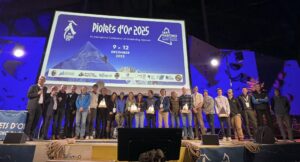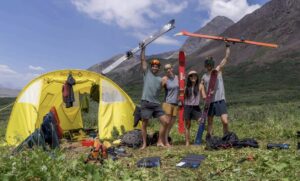Kazuya Hiraide has won three Piolets d’Or, yet still claims he’s not a technical climber. He does his routes in pure alpine style on unclimbed faces. They are bold, direct, scary. They go up mountains so beautiful that is hard to imagine how no one climbed the route before. Then you examine his line’s difficulty, and the light bulb comes on. Most climbers simply wouldn’t dare.
Hiraide, born among the Alps of Nagano, was not meant to be a climber. He has summited Everest three times, as well as some other 8,000’ers, but he does not mention them. He doesn’t even include them in his sports resume.
“I was working [as a cameraman], not pursuing my dreams,” Hiraide explained. But a summit is a summit, right? “Yes, but it is not the summit but the process that matters.”
Hiraide spoke about it all in a long chat with ExplorersWeb, and shortly after, to 500 people packing a theater near Madrid, part of a European lecture tour for sponsor Ternua. While speaking, he avoids technical details. There is no mention of pitches, difficulty, terrain, or climbing stages. He is in front of the public with a mission in mind. He feels the need to explain not what, but why he climbs.

Hiraide during his lecture in Madrid. Photo: @dariodesnivel
Getting out of the stadium
As a child, Hiraide’s first sport was kendo (a modern Japanese martial art). He asked his father to join the local dojo because his older brother had started practicing first. There was no fraternal amity, though. “He always bullied me and I wanted to learn kendo to fight him. To beat him,” he said.
Once he’d beaten his brother, he switched to a drastically different sport: race walking. Hiraide was very good, rising to the top ten in Japan. But he felt restricted by the regulations, the rules, and the certainty of the goal.
“I knew where the start and the finish line were. The track was clear and sign-posted. At some point, I felt I wanted to get out of the stadium, out of everything,” Hiraide said.

Free to choose his own goals. Hiraide in his tiny bivy tent on Shispare. He climbs in pure alpine style, never leaving a trace on the mountain. Photo: Ternua.com
If there is a reason why the young Hiraide turned his eyes to the mountains, it was because up there on the snow and ice, there are no trails and no rules. “Most of all, I wanted to choose my own goals, my own finish lines.”
Or so he thought. He joined his first Himalayan expedition in 2002, a rookie in a large group on Cho Oyu’s normal route.
“What I found on Cho Oyu was a lot of people! I followed the trail on fixed ropes and all I did was pass one climber, then another, then another…I noticed I was doing exactly the same as I did as an athlete: competing with others. After that experience, I promised myself I would get out of the stadium, once and for all,” he said.
Blank spaces on the map
“When I got home, I spread out a big map of the Himalaya on the table. I started marking the peaks that had already been climbed with a dot,” he explained. “When I finished, I saw there were some blank spaces on my map, some patches of mountains with no dots. I wondered why. Was it because of geography? Were they inaccessible? Or was it that no one had noticed them before? I had to go and see for myself.”
A few years later, he held his first Piolet d’Or, awarded for a new route up 7,756m Kamet, the second-highest mountain in northern India’s Garhwal. But by then, Hiraide had something much more important: a dream mountain, and a like-minded partner.
“The first time I saw Shispare, it was so beautiful, so tall, so unreachable…I knew I would have to grow as a climber, but also as a person, to be able to climb that mountain.”
His climb on Kamet was part of that preparation process. Both for him and his climbing companion.

Hiraide and Taniguchi get their first Piolet d’Or. Taniguchi became the first woman to receive the award. Photo: Piolet d’Or
The loves of his life
“Kei Taniguchi suddenly appeared in my life in 2004,” Hiraide recalls. “She was strong, more experienced (she was seven years older than Hiraide), and had a dazzling personality. She decided to join my dream from the first moment. When I told her about my dream mountain, Shispare, she engaged with the project enthusiastically. She shared my dream so fiercely, she almost stole it from me!”
Yet the dream of Shispare was anything but easy. Hiraide would need three attempts, 15 years, and a terrible learning process to accomplish it.
“On the first attempt, I thought that if I put all I had in me, even my life into the attempt, I would make it,” Hiraide reflects. “On the second attempt, I found out that even if I put in everything, I might not reach the summit. That was when I started feeling afraid of the mountain.”
“After that second try, I was ready to renounce Shispare and never return,” he explained. But then something happened: Kei Taniguchi died in a climbing accident in Japan. “I sunk. I broke down,” Hiraide said.
It took him a year to process her death and realize that he had to return to their dream mountain. He had to return to live again.
That was the motivation, Taniguchi’s spirit, that led him to the summit. There, Hiraide placed a photograph of her, smiling in a field of yellow flowers, and prayed.
“It was only then, on that summit, in the fog and wind, that I assumed that Kei was gone,” he admitted. “I also understood that death is not the end but the beginning of a new way. One needs to start from scratch.”

Hiraide buried this picture of Kei Taniguchi (at Diran Peak’s Base Camp) in the snow, on Shispare’s summit. Photo: Kazuya Hiraide
Hiraide still finds it hard to speak about. It still hurts. “To reach the summit, there is a long way of pain and suffering you have to take,” he says when people talk to him about his climbing successes.
The next test: failure and frostbite
Shispare won Hiraide his second Piolet d’Or. He completed the emotional climb with a new climbing partner, Kenro Nakajima.

Kenro Nakajima (left) and Kazuya Hiraide back in Base Camp after summiting Karun Koh. Photo: Kazuya Hiraide
“Kenro reminded me of myself 10 years ago. He was very strong and very oblivious, he ignored the risks of climbing,” Hiraide says. “I felt I had to teach him, protect him somehow, because I thought that if he goes to the mountains with others like himself, he will probably die soon.”
Rakaposhi, in 2019, was another triumph, though it was actually Plan B. Hiraide’s original goal was Tirich Mir, but he couldn’t get a climbing permit. From Rakaposhi’s summit, Hiraide could see Shispare, the mountain that had prepared him for the task.

Hiraide looks to Shispare from Rakaposhi’s summit, 2019. Photo: Ternua.com
The COVID pandemic halted Hiraide’s climbing plans, along with everyone else’s. By the time he was able to travel abroad again, it was nearly winter 2021. He set his sights on another peak not far from Shispare, Karun Koh. This time, he teamed up with Takuya Mitoro.
The plan was to prepare by climbing neighboring Sami Sar (at first it was described as an unnamed peak). The climbers summited but something went badly wrong. On the way down, Hiraide was seriously frostbitten. Bad weather delayed the helicopter evacuation, which didn’t help.

A frostbitten Hiraide airlifted from Sami Sar, in December 2021. Photo: Kazuya Hiraide
“In the helicopter taking me to the hospital in Gilgit, my first feeling was of relief. I was going to get treatment and would heal. But after some days in shock, the fact that I had not made the right calls dawned on me.”
Extremely self-critical, Hiraide blames himself for not being prepared enough for the task and for letting frostbite happen. “Perhaps that was the moment to finish my climbing career,” he thought.
Hiraide spent about a month in Pakistani hospitals. To his surprise, he received many visits. Local climbers, expedition operators, and friends came to keep him company and offer support. He also received many encouraging messages from acquaintances and strangers on the internet.
“I considered myself an alpinist and therefore meant to inspire others…but during those weeks, it was others who motivated and encouraged me. It meant so much! Quitting stopped being the only option in my mind. I started thinking of recovering and maybe looking for some alternative peak, or even returning to Karun Koh.”
Blind climbing
The recovery was long but Hiraide was determined. In the end, he returned to Karun Koh in September this year. Again, he would climb with Nakajima. Hiraide knew he had made the right call when he stood where the helicopter had picked him up a year before.

Nakajima and Hiraide (right) at Karun Koh Base Camp, where Hiraide was airlifted out the year before. Photo: Kazuya Hiraide
Route details are vague and Hiraide didn’t get into technical features. Nevertheless, it is a 1,800m route up the very center of Karun Koh’s northwest face, done with two bivouacs on the wall.
Rather than route details, Hiraide preferred to speak about uncertainty. “The main question surrounding our route was if there was a route at all,” he said. “No matter how much I looked through binoculars in Base Camp, there was a section of the face that was hidden.”
“We considered abandoning but if there was no way to continue I wanted to see that with my own eyes. So we went for it.” The result may earn him a fourth Piolet d’Or.

Hiraide and Nakajima’s route on Karun Koh. Photo: Barrabes.com
Looking for questions: K2 and Everest
“I have a special sense of smell to sniff out challenges,” Hiraide says. Asked what constitutes a challenge for him, he answers: “I look for questions waiting to be answered. Where others have already been, it’s the known world. I look for the unknown, for the blank patches on the map, and for new paths.”
That is the reason why he didn’t mention Everest as part of his climbing career, despite having climbed it three times.
“For me, all the questions on Everest have been answered, I have no interest,” he says. “Yet I respect all those who climb, in whichever style. For them, the mountain does pose questions.”

Hiraide (right) and Yuichiro Miura, with whom he climbed Everest, filming Miura’s ascent at 80 years old. Photo: Kazuya Hiraide
K2 might be considered the opposite, the biggest unanswered question in mountaineering. Some time ago, Hiraide told the media that his recent climbs on Rakaposhi and Karun Koh were meant to prepare him for the West Face of K2. But Hiraide seems to have reconsidered.
“I am not so sure anymore. K2’s West face is an enormous, extremely difficult project. At the same time, K2 has changed a lot,” he explained. “I would not feel comfortable in the huge, overpopulated Base Camp. The descent route would be fixed, although that would have a positive side as I could focus solely on the ascent.”
“Decisions are not written in stone, they may change, with life. Right now, I have a mountain in mind that I will try to climb next year, another blank gap to fill,” he explained, while declining to reveal the specific mountain. “Perhaps when I am done with it, I may feel ready for K2, or maybe I go somewhere else. My alpinism is free and without rules.”

Kazuya Hiraide on Shispare’s ramps. Photo: Ternua.com






